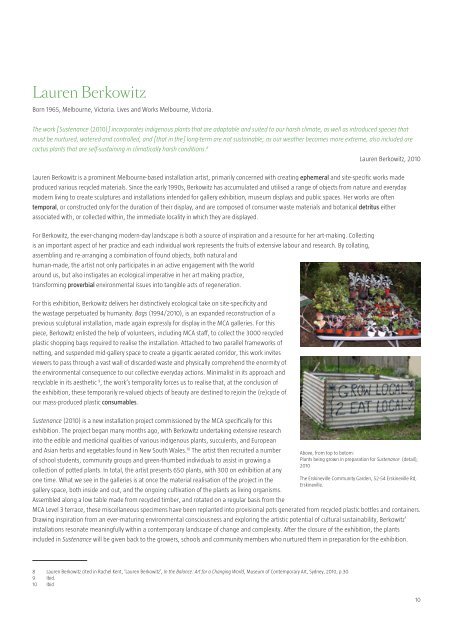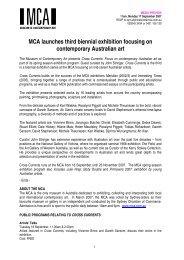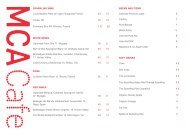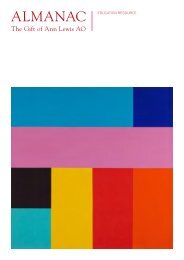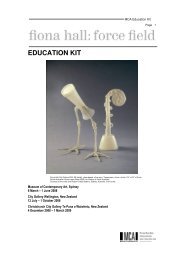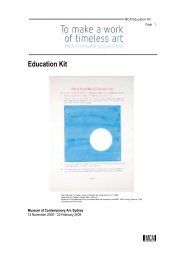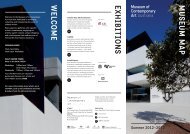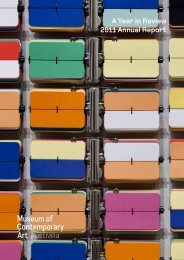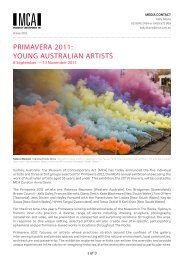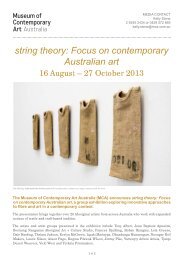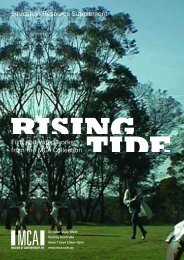Download - Museum of Contemporary Art
Download - Museum of Contemporary Art
Download - Museum of Contemporary Art
You also want an ePaper? Increase the reach of your titles
YUMPU automatically turns print PDFs into web optimized ePapers that Google loves.
Lauren Berkowitz<br />
Born 1965, Melbourne, Victoria. Lives and Works Melbourne, Victoria.<br />
The work [Sustenance (2010)] incorporates indigenous plants that are adaptable and suited to our harsh climate, as well as introduced species that<br />
must be nurtured, watered and controlled, and [that in the] long-term are not sustainable; as our weather becomes more extreme, also included are<br />
cactus plants that are self-sustaining in climatically harsh conditions. 8 Lauren Berkowitz, 2010<br />
Lauren Berkowitz is a prominent Melbourne-based installation artist, primarily concerned with creating ephemeral and site-specific works made<br />
produced various recycled materials. Since the early 1990s, Berkowitz has accumulated and utilised a range <strong>of</strong> objects from nature and everyday<br />
modern living to create sculptures and installations intended for gallery exhibition, museum displays and public spaces. Her works are <strong>of</strong>ten<br />
temporal, or constructed only for the duration <strong>of</strong> their display, and are composed <strong>of</strong> consumer waste materials and botanical detritus either<br />
associated with, or collected within, the immediate locality in which they are displayed.<br />
For Berkowitz, the ever-changing modern-day landscape is both a source <strong>of</strong> inspiration and a resource for her art-making. Collecting<br />
is an important aspect <strong>of</strong> her practice and each individual work represents the fruits <strong>of</strong> extensive labour and research. By collating,<br />
assembling and re-arranging a combination <strong>of</strong> found objects, both natural and<br />
human-made, the artist not only participates in an active engagement with the world<br />
around us, but also instigates an ecological imperative in her art making practice,<br />
transforming proverbial environmental issues into tangible acts <strong>of</strong> regeneration.<br />
For this exhibition, Berkowitz delivers her distinctively ecological take on site-specificity and<br />
the wastage perpetuated by humanity. Bags (1994/2010), is an expanded reconstruction <strong>of</strong> a<br />
previous sculptural installation, made again expressly for display in the MCA galleries. For this<br />
piece, Berkowitz enlisted the help <strong>of</strong> volunteers, including MCA staff, to collect the 3000 recycled<br />
plastic shopping bags required to realise the installation. Attached to two parallel frameworks <strong>of</strong><br />
netting, and suspended mid-gallery space to create a gigantic aerated corridor, this work invites<br />
viewers to pass through a vast wall <strong>of</strong> discarded waste and physically comprehend the enormity <strong>of</strong><br />
the environmental consequence to our collective everyday actions. Minimalist in its approach and<br />
recyclable in its aesthetic 9 , the work’s temporality forces us to realise that, at the conclusion <strong>of</strong><br />
the exhibition, these temporarily re-valued objects <strong>of</strong> beauty are destined to rejoin the (re)cycle <strong>of</strong><br />
our mass-produced plastic consumables.<br />
Sustenance (2010) is a new installation project commissioned by the MCA specifically for this<br />
exhibition. The project began many months ago, with Berkowitz undertaking extensive research<br />
into the edible and medicinal qualities <strong>of</strong> various indigenous plants, succulents, and European<br />
and Asian herbs and vegetables found in New South Wales. 10 The artist then recruited a number<br />
<strong>of</strong> school students, community groups and green-thumbed individuals to assist in growing a<br />
collection <strong>of</strong> potted plants. In total, the artist presents 650 plants, with 300 on exhibition at any<br />
one time. What we see in the galleries is at once the material realisation <strong>of</strong> the project in the<br />
gallery space, both inside and out, and the ongoing cultivation <strong>of</strong> the plants as living organisms.<br />
Assembled along a low table made from recycled timber, and rotated on a regular basis from the<br />
Above, from top to botom:<br />
Plants being grown in preparation for Sustenance (detail),<br />
2010<br />
The Erskineville Community Garden, 52-54 Erskineville Rd,<br />
Erskineville.<br />
MCA Level 3 terrace, these miscellaneous specimens have been replanted into provisional pots generated from recycled plastic bottles and containers.<br />
Drawing inspiration from an ever-maturing environmental consciousness and exploring the artistic potential <strong>of</strong> cultural sustainability, Berkowitz’<br />
installations resonate meaningfully within a contemporary landscape <strong>of</strong> change and complexity. After the closure <strong>of</strong> the exhibition, the plants<br />
included in Sustenance will be given back to the growers, schools and community members who nurtured them in preparation for the exhibition.<br />
8 Lauren Berkowitz cited in Rachel Kent, ‘Lauren Berkowitz’, In the Balance: <strong>Art</strong> for a Changing World, <strong>Museum</strong> <strong>of</strong> <strong>Contemporary</strong> <strong>Art</strong>, Sydney, 2010, p.30<br />
9 Ibid.<br />
10 Ibid<br />
10


